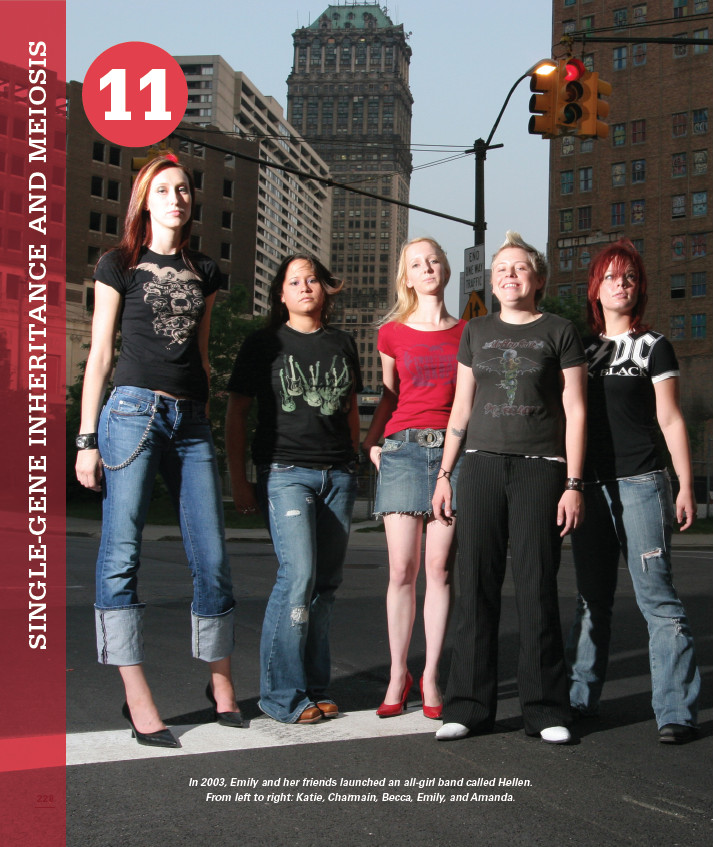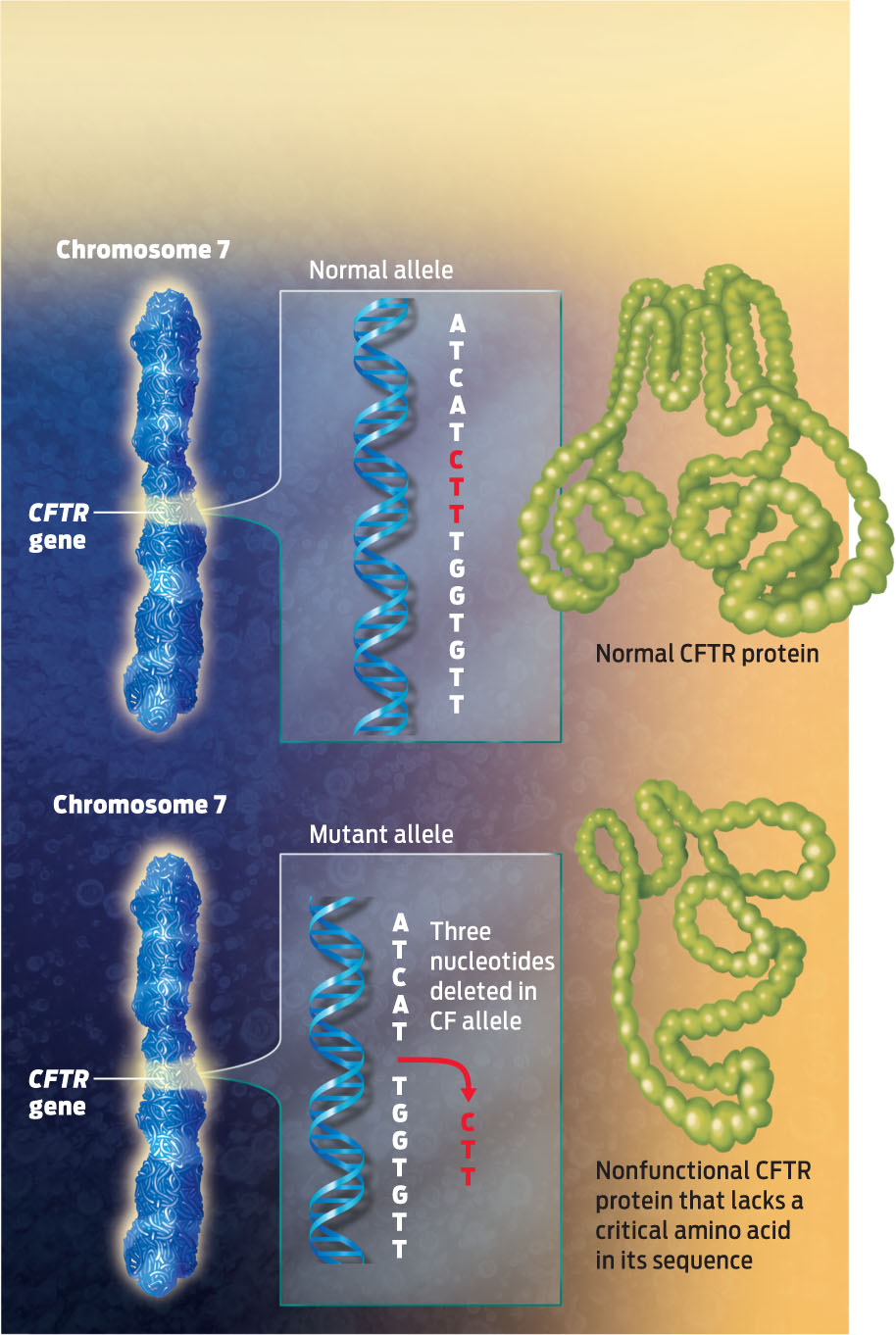


 DRIVING QUESTIONS
DRIVING QUESTIONS
- How does the organization of chromosomes, genes, and their alleles contribute to human traits?
- How does meiosis produce gametes?
- Why do different traits have different inheritance patterns?
- What are some practical applications of understanding the genetic basis of human disease?
In-Class Activity
Click here to access Lecture ppt specifically designed for chapter 11.
Click here to access Clicker Questions specifically designed for chapter 11.
 MILY SCHALLER HAD NO IDEA THAT HER DETROIT-BASED rock band would be strumming its way to fame one day. Back in 2003, she and her friends were goofing around singing songs when someone floated the idea of forming a band. None of them could play guitar, bass, or drums, but that didn’t stop them. “We just went out and bought a bunch of instruments,” says Emily, who chose to play drums. The friends practiced in Emily’s parents’ basement. Her older brother overheard the original mix of punk and classic rock songs that the five girls put together and was so impressed he asked them to open for his own band on New Year’s Eve. The five-girl rock ‘n’ roll band called Hellen was born.
MILY SCHALLER HAD NO IDEA THAT HER DETROIT-BASED rock band would be strumming its way to fame one day. Back in 2003, she and her friends were goofing around singing songs when someone floated the idea of forming a band. None of them could play guitar, bass, or drums, but that didn’t stop them. “We just went out and bought a bunch of instruments,” says Emily, who chose to play drums. The friends practiced in Emily’s parents’ basement. Her older brother overheard the original mix of punk and classic rock songs that the five girls put together and was so impressed he asked them to open for his own band on New Year’s Eve. The five-girl rock ‘n’ roll band called Hellen was born.
“It’s getting really huge,” says Emily excitedly. Hellen performs almost every weekend in Detroit and is now taking its show on the road, with gigs scheduled in Cleveland, Chicago, and soon, Emily hopes, New York City. The band’s unplanned success has given Emily an opportunity to raise awareness about a cause very close to her heart.
MUTATION A change in the nucleotide sequence of DNA.
Emily may look like a typical rock ‘n’ roller, with her bleached blond hair and tattooed forearms, but her carefree appearance masks a serious underlying condition. Emily has cystic fibrosis (CF), a genetic disease she inherited from her parents, and each day she takes a cocktail of drugs and vitamins to help cope with the disease. CF has many symptoms, the most dangerous of which is mucus that clogs airways in the lungs and makes it difficult to breathe. People with CF also can’t digest food well–mucus blocks the passageways through which the digestive enzymes travel to the intestines. So Emily must swallow enzymes before each meal to ensure that her body gets enough nutrients. She’s grown accustomed to the pills–upward of 40 per day–but having to take such meticulous care of her health is hardly routine for most 25-year-olds.
Every year, approximately 2,500 babies are born with CF, making this the most common fatal genetic disease in the United States. In 1989, a team of scientists led by Lap Chee Tsui at Toronto’s Hospital for Sick Children and Francis Collins, then at the University of Michigan, discovered that the disease is caused by mutations in a specific gene that sits on chromosome 7. A mutation is a change in the nucleotide sequence of DNA, which creates a new allele of a gene. As we saw in Chapter 8, alleles are alternative nucleotide sequences of the same gene. Most genes have not just one allele but several, each created by genetic mutation. Tsui and Collins (who would later head the Human Genome Project and the National Institutes of Health) discovered that CF is caused by mutations in a gene called CFTR. This gene codes for the protein known as the cystic fibrosis transmembrane regulator (CFTR), which shuttles ions in and out of cells throughout the body.
Every year, approximately 2,500 babies are born with CF, making this the most common fatal genetic disease in the United States.
The discovery was a milestone. Now that they knew the gene responsible, scientists could study how mutations in the gene make people sick. Because genes provide instructions for making proteins, a change in gene sequence can change the function or shape of a protein. A variety of mutations in the CFTR gene can cause CF. In the most common CF allele, three nucleotides within the CFTR gene are deleted. People who carry this allele produce a defective CFTR protein. This slight change wreaks havoc on the body: the lungs, sweat glands, and pancreas no longer function normally (INFOGRAPHIC 11.1).
Cystic fibrosis (CF) is caused by a variety of mutations in the cystic fibrosis transmembrane regulator (CFTR) gene that sits on chromosome 7. One such mutation consists of a deletion of three consecutive nucleotides, which creates a CF-associated mutant allele. Consequently, the mRNA expressed from this allele has a missing codon and the resulting protein lacks an amino acid in a specific location, rendering the protein nonfunctional.

Today, more than 20 years later, scientists understand the disease better, and this has led to better drugs and therapies to treat symptoms; people with CF are living longer than ever. But despite scientific advances, there is still much to learn. One aspect of the disease that scientists are studying intensively is that people with identical CF alleles vary in the course of their disease—some have worse symptoms and live shorter lives than others. In recent years, scientists have discovered that there are other genes that contribute to a patient’s overall health—so-called modifier genes. That discovery is leading to exciting new therapies that may extend Emily’s life and the lives of thousands of other people with CF.